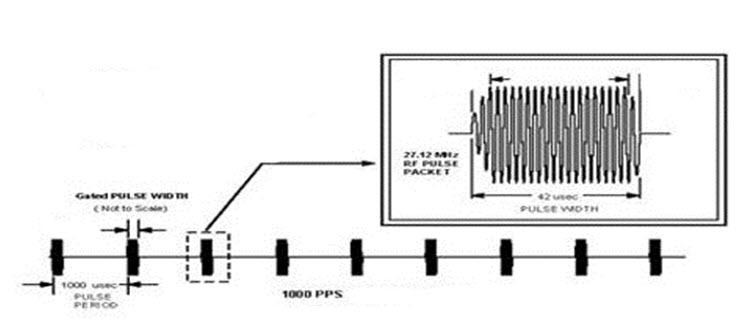 | ||
Pulsed radiofrequency is the technique whereby radio frequency (RF) oscillations are gated at a rate of pulses per second (cycles per second, defined as a hertz (Hz)). Radio frequency energies occupy 1.0 x 104 Hz to 3.0 x 1011 Hz of the electromagnetic spectrum. Radio frequency electromagnetic energy is routinely produced by RF electrical circuits connected to a transducer usually called an antenna.
Contents
Pulsed radio frequency waveforms
The figure below shows an example of a generalized pulsed radio frequency waveform as seen with an oscilloscope with an antenna probe. In this example there are 1000 pulses per second (1 kHz pulse rate) with a gated pulse width of 42 µs. The pulse packet frequency in this example is 27.125 MHz of RF energy. The duty cycle for a pulsed radio frequency is the percent time the RF packet is on, 4.2% for this example ([0.042 ms X 1000 pulses divided by 1000 ms/s] X 100). The pulse packet form can be a square, triangle, ramp or sine wave. In several applications of pulse radio frequency, such as radar, times between pulses can be modulated.
Use in radar
The best understood and applied use of pulse radio frequency electromagnetic energy is their use in radar (radio detection and ranging). The uses of radar are diverse and applied to military, civilian and space exploration. Radar is based on the reflection or scatter of pulsed radiofrequency waves emitted from a transmitter which are then detected by an antenna which then determines the range, speed, and direction of objects. In most uses the transmitter and detector are located at the same location. Radio frequencies used with radar are from 3 MHz to 300 GHz depending on the type and application.
Therapeutic uses
Pulsed radiofrequency fields are an emerging technology used in the medical field for the treatment of tumors, cardiac arrhythmias, chronic and post-operative pain, bone fracture, and soft tissue wounds. There are two general categories of pulsed radiofrequency field therapies based on their mechanism of action: thermal and non-thermal (athermal). While thermal radiofrequency ablation for tumors and cardiac arrhythmia has been used for over 25 years, non-thermal pulsed radio frequency is currently being developed for the ablation of cardiac arrhythmias and tumors. The technique uses pulsed radio frequency energy delivered via catheter at frequencies of 300–750 kHz for 30 to 60 seconds Thermal pulsed radio frequency takes advantage of high current delivered focally by an electrode to ablate the tissue of interest. Generally the tissue/electrode temperature reached is 60 to 75 °C resulting in focal tissue destruction. Thermal pulse radio frequency ablation has also been used for lesioning of peripheral nerves to reduce chronic pain. Non thermal therapeutic uses of pulsed radio frequency are currently being used to treat pain and edema, chronic wounds, and bone repair. Pulsed radiofrequency therapy technologies are described by the acronyms EMF (electromagnetic field), PEMF(pulsed electromagnetic fields), PRF (pulsed radiofrequency fields),and PRFE(pulsed radiofrequency energy). These technologies have been varied in terms of their electric and magnetic field energies as well as in the pulse length, duty cycle, treatment time and mode of delivery. Although pulsed radiofrequency has been used for medical treatment purposes for decades, peer reviewed publications accessing the efficacy and physiological mechanism(s) are now starting to appear addressing this technology.
